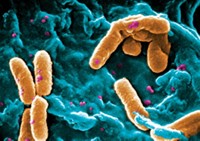Advertisement
Grab your lab coat. Let's get started
Welcome!
Welcome!
Create an account below to get 6 C&EN articles per month, receive newsletters and more - all free.
It seems this is your first time logging in online. Please enter the following information to continue.
As an ACS member you automatically get access to this site. All we need is few more details to create your reading experience.
Not you? Sign in with a different account.
Not you? Sign in with a different account.
ERROR 1
ERROR 1
ERROR 2
ERROR 2
ERROR 2
ERROR 2
ERROR 2
Password and Confirm password must match.
If you have an ACS member number, please enter it here so we can link this account to your membership. (optional)
ERROR 2
ACS values your privacy. By submitting your information, you are gaining access to C&EN and subscribing to our weekly newsletter. We use the information you provide to make your reading experience better, and we will never sell your data to third party members.
Environment
Nanoparticles Accumulate In The Food Chain
Nanomaterials: Gold nanoparticles become more concentrated as they move from plants to herbivores
by Rachel A. Zurer
December 14, 2010
| A version of this story appeared in
Volume 88, Issue 51

A new study provides the first evidence that nanoparticles can build up in a terrestrial food chain. Researchers at the University of Kentucky found that gold nanoparticles accumulate in tobacco plants and then concentrate further in the caterpillars that eat them (Environ. Sci. Technol., DOI: 10.1021/es103031a).
Increasingly, manufacturers add nanomaterials such as silver, zinc oxide, and titanium dioxide to clothing and cosmetics. As a result, the chemicals have started to appear in municipal wastewater, says Kentucky environmental chemist Paul Bertsch. When wastewater reaches a treatment plant, about 90% of the nanoparticles end up in the solid portion of the treatment end products Farmers apply millions of tons of those solids each year to agricultural land, where the nanoparticles could accumulate.
Bertsch and his colleagues previously showed that earthworms can accumulate gold nanoparticles straight from the surrounding soil. They next wanted to see whether the gold nanoparticles could move within a food web from plants to animals that eat them.
The researchers grew tobacco plants (Nicotiana tabacum) in a greenhouse in hydroponic solutions containing high concentrations of 5-, 10-, or 15-nm gold nanoparticles, which are relatively non-reactive and easy to trace. After the researchers fed the spiked plants to the agricultural pest known as tobacco hornworms (Manduca sexta), they mapped the distribution of nanoparticles in the plants and the caterpillars using, respectively, X-ray fluorescence and laser ablation inductively coupled mass spectrometry. They found nanoparticles throughout the plants' leaves and concentrated in the hornworms' tissues.
The big surprise, says Bertsch, was that the nanoparticles were an order of magnitude more concentrated in the caterpillars than in the plants. He thinks that’s because the caterpillars don't shed the gold efficiently. If organisms can't eliminate nanomaterials, Bertsch worries that the chemicals could magnify as predators eat herbivores, possibly causing harm to animals near the top of the food chain.
R. David Holbrook, a chemical engineer at the National Institute of Standards and Technology, calls the tobacco hornworm data "noteworthy" because they demonstrate that the gold nanoparticles biomagnify, just as the notorious pollutants mercury and DDT do. "When we see something that can build up in a food chain," he says, "that gives people working in the environmental field a lot of pause."





Join the conversation
Contact the reporter
Submit a Letter to the Editor for publication
Engage with us on Twitter